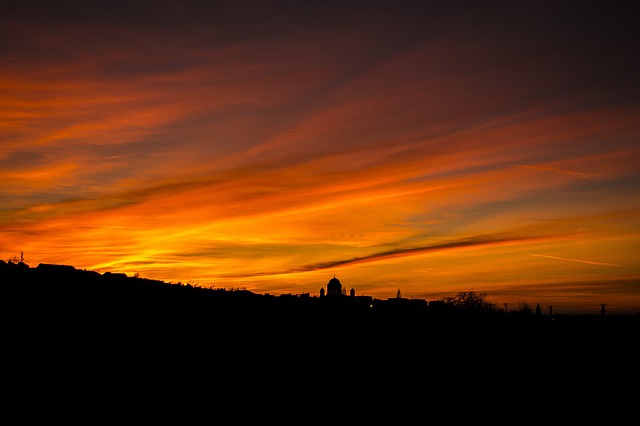
The sky is the part of the atmosphere or of outer space visible from the surface of any astronomical object. It is difficult to define precisely for several reasons. During daylight the sky of Earth has the appearance of a deep blue surface, as the result of the air’s scattering of sunlight. The sky is sometimes defined as the denser gaseous zone of a planet’s atmosphere. At night the sky has the appearance of a black surface or region scattered with stars.
During the day the Sun can be seen in the sky, unless covered by clouds. In the night sky (and to some extent during the day) the moon, planets and stars are visible in the sky. Some of the natural phenomena seen in the sky are clouds, rainbows, and aurorae. Lightning and precipitation can also be seen in the sky during storms. On Earth, birds, insects, aircraft, and kites are often considered to fly in the sky. As a result of human activities, smog during the day and light radiance during the night are often seen above large cities (see also light pollution).
In the field of astronomy, the sky is also called the celestial sphere. This is an imaginary dome where the sun, stars, planets, and the moon are seen to be travelling. The celestial sphere is divided into regions called constellations.
Sky luminescence and colors

The light from the sky is a result of the scattering of sunlight, which results in a light blue color perceived by the human eye. On a sunny day Rayleigh Scattering gives the sky a blue gradient — dark in the zenith, light near the horizon. Light that comes in from overhead encounters an air mass 1/38th of the mass that of a sunbeam coming along a horizon paths. So, fewer particles scatter the zenith sunbeam, and, therefore the light remains a darker blue.
The sky can turn a multitude of colors such as red, orange and yellow (especially near sunset or sunrise) and black at night. Scattering effects also partially polarize light from the sky.
Sky luminance distribution models have been recommended by the International Commission on Illumination (CIE) for the design of daylighting schemes. Recent developments relate to “all sky models” for modelling sky luminance under weather conditions ranging from clear sky to overcast.
Skygazing
Skygazing is the practice of observing the sky. It is usually done for leisure, out of basic astronomical interest. It includes those amateur astronomy observations done generally with the naked eye or with basic optical aids. When approached with a practical stance, skygazing quickly reveals the magnificence of celestial objects. Simple naked-eye observation of the sky can reveal a great deal about the basics of astronomy and a better understanding of the cosmos, and can be extended by using powerful instruments to study deep space
Shortened article from wikipedia.org. Published under the terms of the GNU Free Documentation License, Version 1.2.
